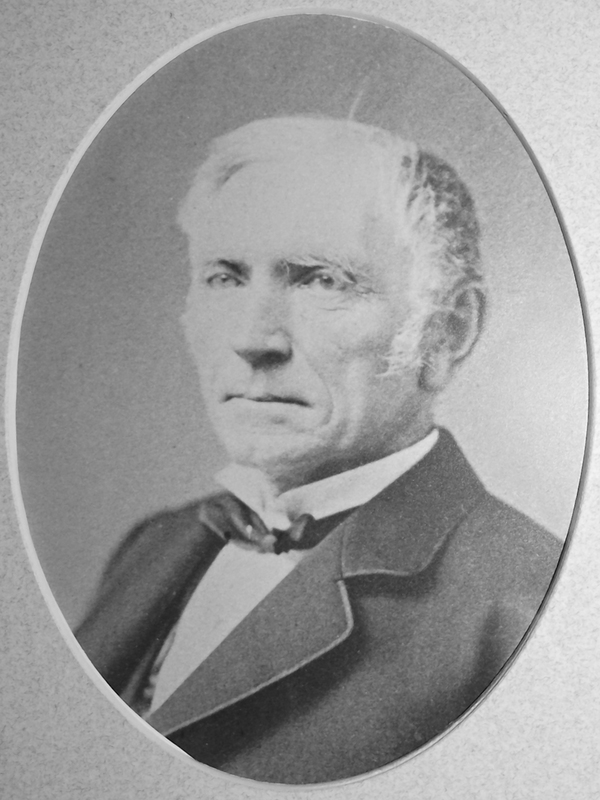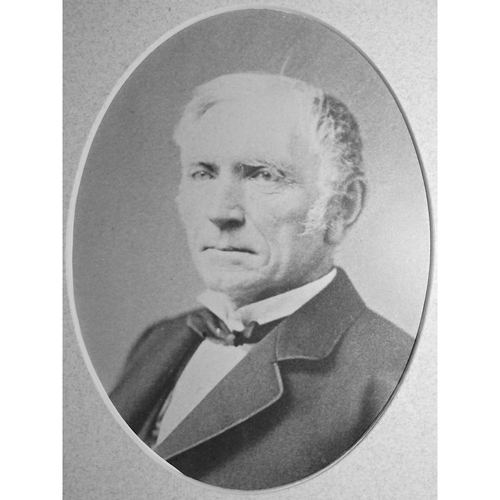
Source: Link
VAIL, EDWIN ARNOLD, physician and politician; b. 19 Aug. 1817 at Sussex Vale (Sussex Corner), N.B., son of John Cougle Vail and Charlotte Hannah Arnold; m. first in 1842 Frances Charlotte Cougle, and they had two sons and two daughters; m. secondly in 1873 Harriet Courtland Murphy, and they had two daughters; d. 31 July 1885 at Sussex, N.B.
Edwin Arnold Vail was a member of a prominent loyalist family. His maternal grandfather, the Reverend Oliver Arnold*, had been the first Church of England rector of Sussex Vale, and his father represented Kings County in the New Brunswick assembly for some 16 years and later served as county registrar. Educated in the local public school, in the early 1830s Vail went to Edinburgh and Glasgow to study medicine and in 1837 was granted an md degree by the University of Glasgow. He returned to his home town and engaged in a successful general practice as a physician in Kings County and in parts of the adjoining counties of Queens, Albert, and Westmorland. From 1838 to 1869 he served as surgeon to the 2nd Battalion of Kings County militia and from 1870 until his death as surgeon to the 74th Battalion of Infantry. He was president of the New Brunswick Medical Society for one year in 1883–84. He was also a charter member of the Medical Council of the College of Physicians and Surgeons of New Brunswick, created in 1881, and served on that body until his death. Vail’s professional skills and his willingness to employ them in the service of the poor as well as the affluent were admired by his contemporaries.
Vail’s long career in New Brunswick politics began in 1857 when he was elected to the assembly for Kings County as a supporter of John Hamilton Gray and the “compact” or Conservative minority in the house. Re-elected in 1861, Vail bitterly opposed the plan of the Liberal leader, Samuel Leonard Tilley*, to bring New Brunswick into confederation. A determined anti-confederate, Vail was re-elected in 1865 when the voters rejected Tilley’s plans for union. Vail was speaker of the assembly under the government of Albert James Smith until in April 1866 Lieutenant Governor Arthur Hamilton Gordon* forced the anti-confederates from office. In the ensuing general election and again in a by-election held the following year, Vail was defeated.
In 1870, still an unrepentant anti-confederate, Vail ran again for the assembly, and on the hustings “manifested great delight in showing that Confederation had proved as bad as he had predicted.” Re-elected, he was again selected speaker when in February 1871 George Luther Hatheway* and George Edwin King* formed a non-party government specifically to pass a law establishing a non-denominational school system supported by direct taxation. Vail did not support the school legislation, but his appointment as speaker limited his participation in the debate. He was defeated in the election of late June 1874, only weeks after the suicide in Sussex of his 26-year-old son, William, also a physician. In the 1878 and 1882 general elections Vail was a successful candidate, and from March 1883 to March 1885 he was a member without portfolio in the Executive Council of the Liberal premier Andrew George Blair*. Following the reappearance after 1878 of more distinct Liberal and Conservative party labels, Vail had allied himself with the Liberal group. On 1 April 1885, just four months before his death, he was appointed to the Legislative Council.
Vail’s public career was not as outstanding as that of his brother, William Berrian Vail*, a prominent Nova Scotia politician and federal minister of militia and defence in Alexander Mackenzie*’s government from 1874 to 1878. While serving in the assembly, however, E. A. Vail, known for his strong opposition to confederation, was also responsible for the passage of legislation which shortened the study of law from five to four years and which provided for all elections to the New Brunswick assembly to be held on the same day. He was also convinced that the Common Schools Act of 1871 which he had criticized did not produce an educational system worthy of the financial burden it placed on his constituents. At his death, Vail was described as a man of “generous impulses and strict integrity” whose “strongest hold on the people of Kings County was rather by reason of his private virtues than his political acts.”
N.B. Museum, Observer [E. S. Carter], “Linking the past with the present” (clippings); G. H. Markham, “Kings County genealogical notes.” PAC, RG 9, 11, B4, 4: 346. PANB, “N.B. political biog.” (J. C. and H. B. Graves). PRO, CO 193/4–48 (blue books, 1821–67) (copies at PAC). N.B., House of Assembly, Journal, 1879; Reports of the debates, 1865–66; Legislative Council, Journal, 1885. Daily News (Saint John, N.B.), 5, 6 June 1874. Daily Sun (Saint John), 1, 2 April, 1 Aug. 1885. Daily Telegraph (Saint John), 29 June 1870, 17 Feb. 1871, 5 March 1883, 1 Aug. 1885. Morning Freeman (Saint John), 18 Feb. 1871, 18 June 1874. Morning News (Saint John), 25 July 1842. Canadian biog. dict., II. CPC, 1885. Dominion annual register, 1878–85. The merchants’ & farmers’ almanack . . . (Saint John), 1840–41; 1843–46; 1852–53; 1855–63. New-Brunswick almanac, 1825–36; 1838–39; 1842; 1846–54; 1864–69; 1882–85. Wallace, Macmillan dict. Hannay, Hist. of N.B. W. B. Stewart, Medicine in New Brunswick . . . (Moncton, N.B., 1974), 45–46, 52–53.
Cite This Article
J. M. Whalen, “VAIL, EDWIN ARNOLD,” in Dictionary of Canadian Biography, vol. 11, University of Toronto/Université Laval, 2003–, accessed January 23, 2025, https://www.biographi.ca/en/bio/vail_edwin_arnold_11E.html.
The citation above shows the format for footnotes and endnotes according to the Chicago manual of style (16th edition). Information to be used in other citation formats:
| Permalink: | https://www.biographi.ca/en/bio/vail_edwin_arnold_11E.html |
| Author of Article: | J. M. Whalen |
| Title of Article: | VAIL, EDWIN ARNOLD |
| Publication Name: | Dictionary of Canadian Biography, vol. 11 |
| Publisher: | University of Toronto/Université Laval |
| Year of revision: | 1982 |
| Access Date: | January 23, 2025 |



